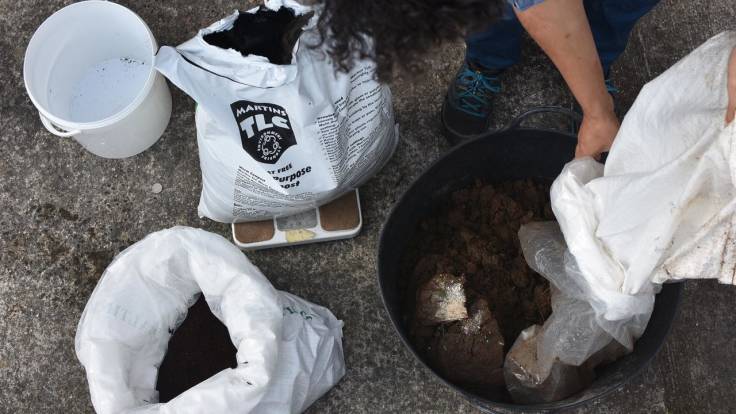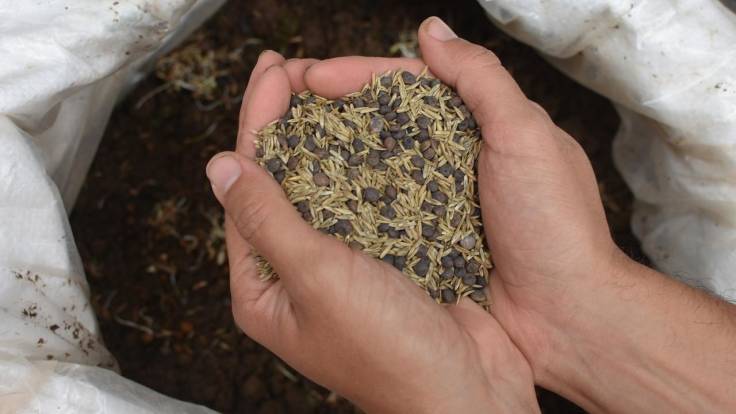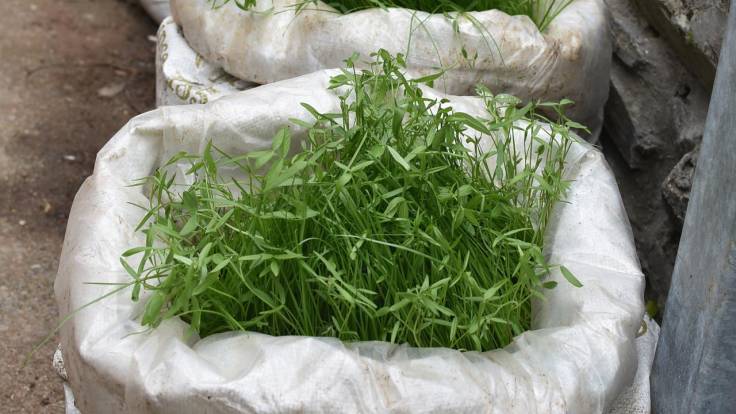
Bait plants growing in woven sack, multiplying the mycorrhizal fungi & ready for harvest
You can make your own arbuscular mycorrhizal fungi inoculant, like rootgrow™, for adding to roots for healthier plants. Notes & photos kindly from Antony & Emma of @HyphaeShroomery. Photos copyright @HyphaeShroomery.
Introduction
Many gardeners add mycorrhizal fungi (like Chaos Fungorum or rootgrow™) to roots when planting. The good people at Hyphae Shroomery very kindly sent instructions from Sunseed Desert Technology on how to make your mycorrhizal fungi inoculant. These are my abbreviated notes.
It will take 3 months to grow the inoculant, and you will need one large 30 litre pot or several smaller ones.
Specifically, it will be arbuscular mycorrhizal fungi (AMF):
- AMF form symbioses with 80% of plant species, including the majority of herbaceous and annual species, most arid and semi-arid woody species and tropical hardwoods.
- The other main type is the Ectomycorrhizal fungi: these colonize the roots of most temperate and boreal tree species – conifers, oaks, beech etc
- A few plant families do not form mycorrhizas, notably the cabbage and beet families. (The main non-mycorrhizal plant families are: Brassicaceae, Amaranthaceae, Caryophyllaceae and Chenopodiaceae (normally)).
1. Collect starter soil
- In temperate regions, hedgerows, thickets and thriving perennial grasslands that have not been cultivated recently are good sources.
- If you plan to use the inoculum with tree seedlings, there can be special benefit in collecting some of the starter soil from under healthy trees of the same species.
- Method: Clear away about half square metre of the vegetation underneath your target plant. Dig down to a depth of about 25cm collecting the soil and as many fine roots as possible. It is better, but not essential, to collect from under several different trees and shrubs.
- With stony soil, sieve it to get rid of large stones.

Mixing the starter soil with peat-free compost to improve fertility and eke out the soil
2. Multiply mycorrhiza
- Position pots where they can be inspected, watered and left alone.
- Fill 30 litre pot or several 5 litre pots with starter soil.
- Choose combination of grassy species (eg maize, millet, sorghum, oats, wheat) or an allium (onion, leek), with a species of legume (beans, peas, lentils, alfalfa, clover).
- These “bait plants” will become infected with the mycorrhizal fungus causing the fungal population to multiply.
- Sow seeds closer than normal, alternating the species.
- Keep regularly watered.

Mixture of grassy and legume seed
3. Harvest
- Ten days before using inoculant, cut down bait plants at base of the stem and stop watering.
- This kills the plant and tricks fungus into producing spores.
- After the ten days, pull up roots, chop into 1cm pieces, mix back into soil.

You can also recycle woven plastic sacks to grow bait plants
4. Using inoculant
- Trees from seed: add inoculant layer ⅓ way down in pot
- Pre-grown trees: add spade-full of inoculant to bottom of hole
- Crops: pinch of inoculant into any hole, or sprinkle in bottom of drill
You may also like the blog post Plants that make mycorrhizal associations on this website.